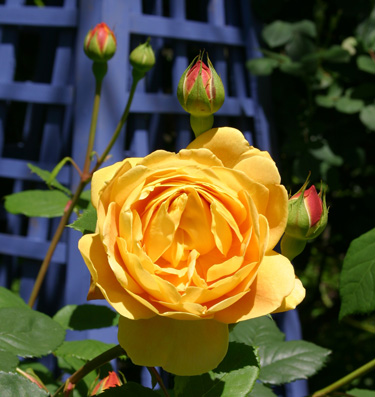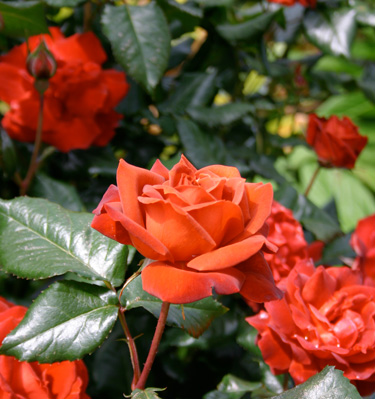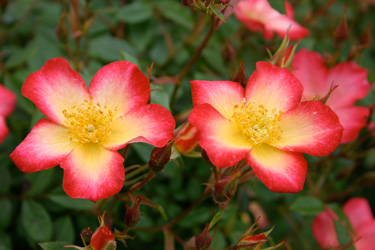Grow your best ever roses
Mosey outdoors on a warm summer morning, secateurs in hand. Marvel at the colours, inhale the scents and witness the bees buzzing happily from flower to flower. It’s practically impossible to feel stress or worry as you absorb yourself in picking a bunch of roses from your very own garden.
They’re the most loved, intoxicatingly beautiful flowers in the world and surprisingly easy to grow. That said, there is quite a difference between growing roses and growing really great roses. Getting the best from your roses starts at the beginning, with choosing the right varieties and planting them with the best possible care. Then it’s simply a matter of basic TLC.
Eight simple ways to get the very best from your roses …
| 1 | Choose well. It may be love at first sight, but you’ll love your roses for longer if you engage your head as well as your heart when deciding which varieties to plant. As well as those to-die-for blooms, there are other important attributes to consider - such as growth habit, foliage, disease resistance and overall performance. Go Gardening centres stock a range of the most reliable varieties. You could also consult your local rose society for varieties that do well in your area. The New Zealand Rose Review published each year by the New Zealand Rose Society is another place you can go for inspiration. This is available at www.nzroses.org.nz .Bear in mind that roses rate well for different reasons, some may be fabulous on a show bench but unremarkable in the garden. Others may have the most eye-catching blooms but no fragrance. Choose a rose that fits its purpose in your garden. There are roses for pots, roses for walls, tall roses, short roses, even ground cover roses. |
| 2 | Invest in top quality plants. Even the most outstanding rose variety may fail to prosper if it’s had an unlucky start in life. Purchase well-grown plants with healthy roots. Buy healthy looking plants with no sign of disease. |
| 3 | Give them sunshine. Most roses will grow and flower quite well in half-day sun, but generally more sun means more flowers. On the other hand, a very hot cloistered spot with no airflow can be a disease trap so make sure your roses are well ventilated. Of course, this must be balanced with the need to provide shelter from harsh, damaging winds. Take care not to plant roses too close to trees as these will deprive them not only of sun, but moisture and nutrients too. |
| 4 | Soil is everything. Because roses are long-lived plants, it is well worth spending time enriching the soil before planting. They perform well on heavy soils that contain clay, as the clay particles hold onto the summer moisture and nutrients that roses thrive on. However, it is important that the soil doesn't become waterlogged. Raising beds 15–20 cm above the ground level and digging in plenty of compost can significantly improve drainage. Conversely, roses can struggle on light sandy soil but this also can be remedied by adding of organic matter. So, whatever your soil, plying it with compost prior to planting can only be good for your roses. Regular mulching further enriches the soil. |
| 5 | Plant with care. Take extra care not to let your roses dry out between purchasing and planting. When planting container grown roses in spring, carefully remove the container and try not to disturb the roots or you may damage the young feeder roots. Start with a generous sized planting hole (at least twice the volume of the roots) then back fill it so that the plant sits so that its bud union (that bump on the stem) sits just above ground level. Mix some sheep pellets or a scoop of slow release fertiliser into and then gently but firmly fill around the roots with soil. Thorough watering after planting helps settle the soil snuggly around the roots. Tip: Try not to plant a new rose plant in soil previously occupied by a rose. Alternatively, replace the soil with soil from another part of the garden, mixed with compost. |
| 6 | Water deeply. Deep infrequent watering encourages young rose roots to grow down into the lower, damper levels of the soil, whereas frequent light watering of the surface encourages shallow roots, vulnerable in dry weather. How often you water depends on your soil, but newly planted roses will need a good soak about once a week in their first summer. Once they’re well established, roses in the garden can cope with minimal watering, but roses in pots need daily watering over summer. If you have lots of roses, opt for soaker hoses or drip irrigation in preference to sprinklers, as wet foliage invites disease. |
| 7 | Cover the soil. A generous layer of organic mulch is worth topping up every spring. This keeps water in and weeds out, while lifting the humus level of your soil – and that means more nutrients and more water can be absorbed by your plants. Maintain a 5-10cm layer. Composted leaves, well rotted animal manures - anything that once lived, is good for your roses. If using un-composted bark or sawdust, add fertiliser first as raw mulch can gobble up the soil’s reserves of nitrogen as it decomposes. |
| 8 | Feed them well. Feed your roses generously and they’ll reward you with loads of top quality blooms. Apply controlled release fertiliser or sheep pellets in early spring and again in summer to support autumn flowering. Roses also respond well to soluble liquid fertilisers applied regularly throughout the flowering season. Many gardeners swear by fish-based fertilisers. |
Bug watch
As the weather heats up, bugs get busy. Roses are a prime target for the likes of aphids and disfiguring fungus diseases. Fortunately there is plenty the gardener can do to minimise the damage.
- Keep them well fed and watered. A healthy well-nourished rose bush is better equipped than a sickly one to defend against an attack from insect pests and fungus disease. Use drip irrigation, not sprinklers as wet foliage encourages disease.
- Foliar feed with liquid seaweed. This increases the plant’s natural immunity to pests and disease.
- Plant disease resistant varieties. Modern rose breeding offers an increasing choice of roses, such as the Flower Carpet range, which remain healthy without the need for spraying.
- Avoid overcrowding. Keep the air flowing around your rose bushes and banish weeds as these harbour pests and increase humidity.
- Be a tidy Kiwi. Clear away all pruning waste and fallen leaves (do not put this disease ridden debris on your compost heap!)
- Apply copper and oil in winter. Problems are significantly less in summer for roses that are treated to a ‘winter cleanup’ spray after pruning. This breaks the pests’ life cycles by killing spores and eggs.
- Spray if necessary during spring and summer. The need to spray depends on your climate and your own personal tolerance levels, as well as that of your roses. Pests and diseases are more prevalent in warm humid climates. Ask for advice on what to spray at your Go Gardening centre. There are many low toxicity and natural sprays available. Systemic products, like Confidor, get inside the plant's sap, killing only the insects that are feeding on your roses, and compared with traditional contact sprays they’re applied less often. The best time to spray is in the evening when you are less likely to harm beneficial insects or sun-scorch the leaves. Always take the recommended safety precautions when spraying, and read the label carefully before use.
- Plant a variety of shrubs and perennials to compliment your roses. This will attract predatory insects, which feed on pests like aphids.
Tip: Aphids on roses can be removed digitally. Teach the kids to squash them with their fingers!

2-Oct-2013

Graham Thomas

Hot Chocolate

English rose Mary Rose

Starry Eyed

Flower Carpet White

